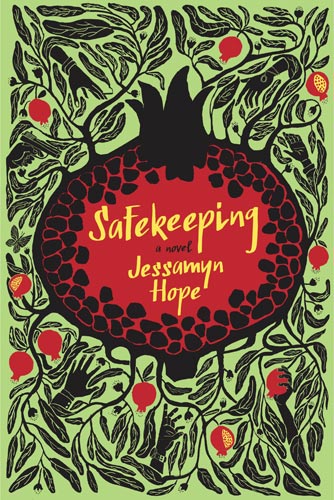Safekeeping
Jessamyn Hope’s debut novel opens with Adam, a 26-year-old drug-addicted burnout, fleeing from New York City to Israel. Adam’s caretaker and closest companion, his grandfather, has recently died. During the airplane ride, Adam broods on whether American authorities are following him. Experiencing withdrawals and toting an odd assortment of belongings, including an elaborate gold brooch, he volunteers to work on a kibbutz. He’s searching for someone. The circumstances of his grandfather’s death, the significance of the brooch, and the identity of whom Adam is searching for drive the thoughtfully plotted Safekeeping. Jessamyn Hope’s debut novel opens with Adam, a 26-year-old drug-addicted burnout, fleeing from New York City to Israel. Adam’s caretaker and closest companion, his grandfather, has recently died. During the airplane ride, Adam broods on whether American authorities are following him. Experiencing withdrawals and toting an odd assortment of belongings, including an elaborate gold brooch, he volunteers to work on a kibbutz. He’s searching for someone. The circumstances of his grandfather’s death, the significance of the brooch, and the identity of whom Adam is searching for drive the thoughtfully plotted Safekeeping.
Adam encounters a diverse cast of characters on the kibbutz. Some of the other volunteers are just as lost as he is. The struggles of Hope’s characters are palpable. A French-Canadian woman compulsively counts steps and particular hand motions, a Soviet refugee enjoys shoplifting and dreaming of New York, and a teenaged Israeli soldier displays a passion for classical music composition. It’s a pleasure to see these characters interact.
Safekeeping’s timeline spans centuries and the brooch’s history serves as a vehicle for providing historical and personal context. The primary action unfolds over several months in 1994, but there is a section titled “Holy Roman Empire, 1347.” There’s more than a tinge of the epic in Safekeeping, and events do occasionally sprawl, but the huge time-jumps most often illuminate the actions of characters living centuries later.
Hope displays a masterful sense for transitioning to and from flashbacks or dream states. I don’t think I’ve ever been quite so excited by such transitions. Some of them are simple and effective:
Adam sat back, hands pressed against his mouth. If only he too would stop breathing. In his grandfather’s fist was the yellowed note, the one that had been in the felt bag with the brooch, the one he had been in too big a hurry to read.
Adam opened his eyes, back again in the kibbutz dorm room.
We can see how that works, but other transitions are exhilaratingly subtle:
Her whole life she had watched people look for that peace—on psychologists’ couches, at ashrams, in nightcaps—when all they had to do was give themselves over to honest labor.
“Hello, Ziva.”
Startled, she turned to Franz, who was short of breath from jogging to catch up.
The word “startled” here does a remarkable amount of work. In the novel’s context, it turns the story from the immediate timeline into a dream-state flashback. Hope doesn’t use this particular word as a regular trope, and the novel contains many other examples of smoothly slipping into, and out of, the past.
First novels are special. They can generate an electric anticipation in me. Simply holding a first novel can cause me to question the ecclesiastical notion of “nothing new under the sun.” Here! I think, I’ve got something completely new right here! I try to temper this anticipation before beginning to read the actual work. It’s not fair to expect any author to trump Solomon, especially right out of the gate. Maybe that’s for second novels. And still, Safekeeping induced that electric anticipation in me throughout its nearly four hundred pages.
Strong suspense, well-sketched characters, and intricate plotting all lead readers to expect greatness from Safekeeping. At the line level, Hope’s descriptions are often striking. “Claudette noticed the old woman appeared very yellow against the tree. Not olive, but unquestionably yellow—her face the ochre of old scotch tape, blue veins bulging on mustardy calves.” And yet, taken as a whole, the novel doesn’t quite build to the lightning bolt greatness it flirts with.
Safekeeping exposes too much of its scaffolding. Plot turns are frequently effective, but also convenient and unsurprising. One major plot point hinges on “. . . the weird sensation that the old woman knew more than she was letting on.” It’s difficult—but not impossible—to effectively hang a narrative on “weird feelings.” One scene features the Israeli soldier standing in a line of soldiers wearing riot gear. Young, angry Palestinians are throwing rocks at him. He becomes overwhelmed by a swell of hatred, looks into his own thoughts, and doesn’t like what he finds. He breaks rank to chase a Palestinian boy into a crowded market. He almost immediately stumbles into a room filled with mirrors.
Safekeeping isn’t lost in the funhouse too often, but it happens just frequently enough to remind you it is a first novel. But Safekeeping is an immersive, impressive first novel. It opens with suspense, is filled with compelling characters, and its timeline opens and closes like an accordion. Who knew an accordion tune could come so close to sounding like a symphony?





